vgthought.com
Bowser as a Big, Scary Turtle Dragon
Posted: 2014-01-30 03:20:15
Last edited: 2014-02-27 19:33:14
Last edited: 2014-02-27 19:33:14
This was originally posted on June 15th, 2010.
In Mario games, Bowser intimidates the player not only by appearance and size, but also by his invincibility. To overcome Bowser, the player must often use indirect methods; the player has little power to harm Bowser directly. This essay reviews the strengths and weaknesses of Bowser in several games, drawing out the elements that define the character of each particular fight.
I personally find Bowser to be at his most effective--that is, in terms of intimidation--in Super Mario Bros. and Super Mario Bros. 3, so those games receive the most attention.
In Mario games, Bowser intimidates the player not only by appearance and size, but also by his invincibility. To overcome Bowser, the player must often use indirect methods; the player has little power to harm Bowser directly. This essay reviews the strengths and weaknesses of Bowser in several games, drawing out the elements that define the character of each particular fight.
I personally find Bowser to be at his most effective--that is, in terms of intimidation--in Super Mario Bros. and Super Mario Bros. 3, so those games receive the most attention.
Games discussed:
Super Mario 64,
Super Mario Bros.,
Super Mario Bros. 3,
Super Mario World,
Super Mario Galaxy,
Super Mario Sunshine,
New Super Mario Bros. Wii
When considering how a video game works on the player--as is the case with the analysis of other art forms--nothing should be taken for granted. With that in mind, Mario’s eternal rival Bowser is not just an enemy that’s harder than any other enemy in the game. He’s a big, scary turtle dragon. This effect is attained through nigh invincibility and intimidating attacks. He always breathes fire, and you can never jump on his head.
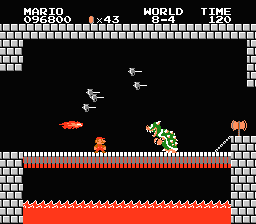
Super Mario Bros. may be the best example of this. Bowser is invulnerable to Mario’s patented jump-on-the-head approach. He stands as a large, dangerous barrier between Mario and victory: Bowser can only be defeated if Mario reaches that ax behind him and cuts the bridge down. Mario’s only hope of victory is indirect. He cannot kill Bowser himself, but he can remove the object which separates Bowser from the lava (namely, the bridge).
That is, of course, unless Mario possesses the ability to throw fireballs. Fire Mario is a rare sight in Super Mario Bros.; Mario must collect two powerups without receiving damage once in order to maintain his Fire Mario state. If the player manages to pull this off, Bowser can also be killed with five fireballs. Fire Mario is a rare, precious state for the player, valued all the more because it offers the only way to kill Bowser without any external help. Even if the player makes it to Bowser as Fire Mario, he or she is still on thin ice; if Mario is damaged once, he loses his ability to throw fireballs. This fragility makes Fire Mario even more rare and precious.
The game itself even rewards the player beyond this. Super Mario Bros. contains seven fake Bowsers, with one real Bowser found in the last castle, 8-4. If one of the fake Bowsers is killed by fireballs, its true identity is revealed to be a petty enemy, such as a goomba. Not only has Mario defeated the fake Bowser through his own power, but he has also defaced the fake Bowser and exposed its true form. Additionally, the player is rewarded bonus points for this kill. Merely grabbing the ax does not give the same satisfaction.
Bowser, then, is a fearsome enemy. If it wasn’t for the ax, he would be invincible a large portion of the time. Fire Mario is highly valued because he can directly harm Bowser, but he is still weak by comparison; with one hit, Mario loses the ability to throw fireballs, while Bowser takes 5 fireballs to go down. The player can become empowered, but is always on the verge of failure, while Bowser stands secure with his 5 hit points.
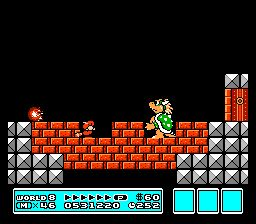
Super Mario Bros. 3 follows this basic pattern. Most of the time, Mario cannot attack Bowser, but instead, must trick him. Bowser will attempt to jump on Mario (appropriate, eh?), and in landing, Bowser will destroy some of the red bricks below him, if there are any. If he destroys the bottom layer of bricks, he falls to his doom.
This reflects upon the Super Mario Bros. Bowser fight in two key ways. First, Mario has no tools to help him; he is even more defenseless. Second, Bowser’s death is heavily reliant upon the direction of the player. In Super Mario Bros., Bowser would die if the player simply touched the ax, and no further effort was required on the player’s part. However, in Super Mario Bros. 3, Bowser follows Mario. The player must lead Bowser to his death; if the player does not trick Bowser into destroying red bricks, he will not die. This provides a juxtaposition between player dependent elements (those elements of the game that change based on the player's behavior) and player independent elements (those elements of the game that do not change based on the player's behavior). On one hand, the progress of the fight is held back by the game on is own; Bowser is resistant to many of the player’s attacks, so the player cannot affect him directly. On the other hand, Bowser tracks the player’s movements; Bowser’s own attacks are indirectly defined by the player. This is not to say that Mario and Bowser are on equal footing, though, since Bowser still has the advantage in terms of offensive power and defense.
So Mario, for the most part, is unable to attack Bowser directly in Super Mario Bros. 3, as was the case in Super Mario Bros. However, Fire Mario can kill Bowser with 25 fireballs, and Hammer Mario can kill Bowser with 10 hammers. Reaching Bowser in either of these states is a feat, since Mario loses them if he is damaged even once. In addition, the Hammer Suit is rarer than the Fire Flower; the Fire Flower is found in many ? boxes in the game, while the Hammer Suit is only found in select Toad Houses and giant ? blocks. The more rare and fragile the state, the more precious it is; Hammer Mario can kill Bowser faster than Fire Mario, and both Fire and Hammer Mario can kill Bowser directly, which is normally impossible for Mario. In Super Mario Bros., Fire Mario was valued for its power over Bowser; for this reason, in Super Mario Bros. 3, Fire Mario is valued over normal Mario and Hammer Mario is valued over Fire Mario.
Tanooki Mario can kill Bowser with one hit. However, much like the Hammer Suit, the Tanooki Suit is rare. In addition, it’s not immediately clear how to damage Bowser with the Tanooki Suit. The player must realize that Tanooki Mario can attack an enemy by turning into a statue and landing on its head. Unlike the hammer attack, there is an element of secrecy to the Tanooki Mario approach.
This initial formula provides an interesting lens through which to view subsequent battles between Mario and Bowser. Let’s take a quick look.
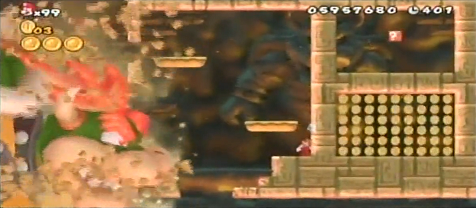
New Super Mario Bros. Wii and Super Mario Sunshine revisit the player dependent/independent juxtaposition without giving Mario any opportunity for a direct attack. In New Super Mario Bros. Wii, Bowser’s final form chases Mario through the castle. As he does this, he breathes fire at Mario. This fire breath not only hurts Mario, it destroys walls. Mario must trick Bowser into breathing fire at key walls in order to escape. Powerups such as the Propeller Suit will make it easier to dodge Bowser’s attacks, but no powerup allows the player to damage Bowser. Bowser is only killed when Mario reaches the end of the course and presses a button, releasing the floor beneath Bowser’s feet--an indirect victory.
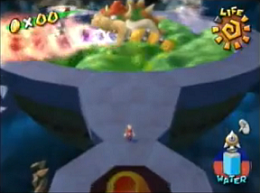
In Super Mario Sunshine, Bowser and Bowser Jr. both aim their attacks at Mario, defining their attacks by Mario’s location. Mario must launch an indirect attack, destroying the pool holding Bowser in order to send him plummeting. Mario has no option for attacking Bowser directly.
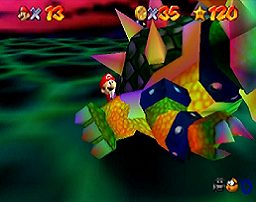
On the other hand, Mario is strangely empowered in Super Mario 64. He slings Bowser by the tail into bombs which surround the stage. Mario cannot harm Bowser himself, but he still demonstrates power over Bowser by throwing him. As a result, Mario is not subject to Bowser’s attack pattern; instead, Bowser is subject to Mario’s whims. Rather than working around Bowser, the player can send Bowser wherever he or she pleases.
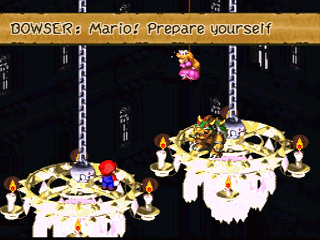
That’s an RPG. This article isn’t about RPGs.
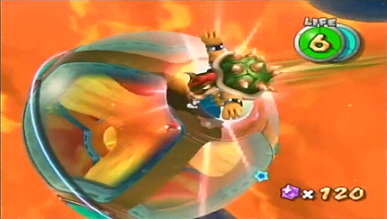
Super Mario Galaxy strikes a balance between the empowered Super Mario 64 Mario and the Mario of Super Mario Sunshine who may only attack indirectly. In Super Mario Galaxy, Bowser is invincible until Mario can trick him into landing in lava. At this point, Mario is able to attack him directly with a swing of his fists: the attack that defines Mario’s moveset in Super Mario Galaxy. This attack is only present in Super Mario Galaxy, and it is used a countless number of times throughout the game. Rather than empower Mario, the player can weaken Bowser to the point where he is susceptible to one of Mario’s most basic attacks of the game.
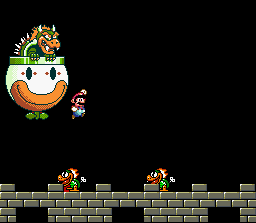
In Super Mario World, Bowser is invincible to any of Mario’s own attacks. Instead, Mario must wait for Bowser to throw down Mecha Koopas, at which point Mario must throw them back at him. This battle is hard to see in the same light as Super Mario Bros. and Super Mario Bros. 3. Mario must use Bowser’s attack against him--which, in a sense, follows from the Super Mario Bros. 3 battle--but the attack is underwhelming; Mecha Koopas are hardly a threat. Practically speaking, Mecha Koopas are large Goombas, since they only walk left and right, waiting for Mario to jump on them and pick them up. In addition, the Mecha Koopas allow the player to directly attack Bowser; Mario doesn’t wait for Bowser to fall through a hole, he inflicts damage on Bowser. Regardless of Mario’s state, he’s still able to hurt Bowser. This contradicts the near invincible Bowser of almost every other Mario game. Of course, there are other ways to compare this fight to earlier Bowser fights, but in terms of Bowser’s vulnerability, comparisons are difficult to make.
comments powered by Disqus
All original content on VG Thought was written by Greg Livingston AKA Golem.